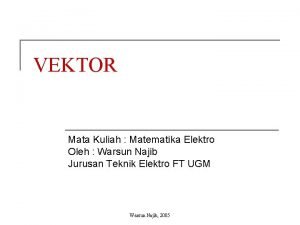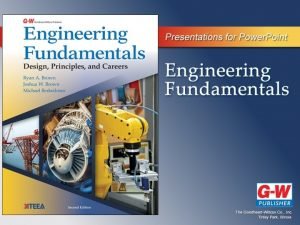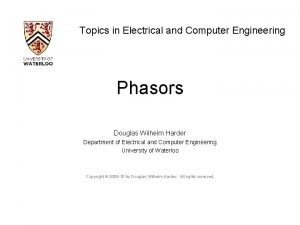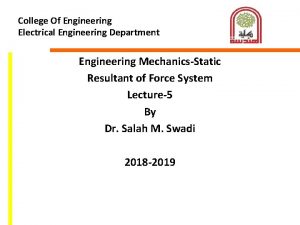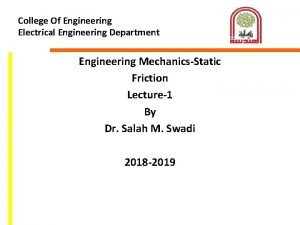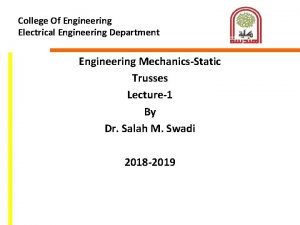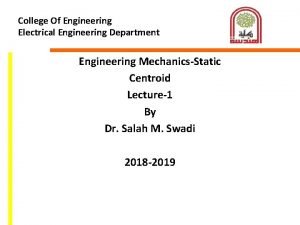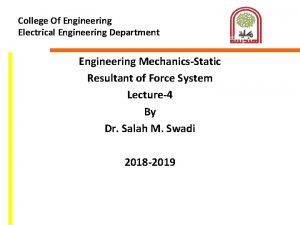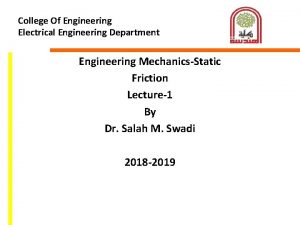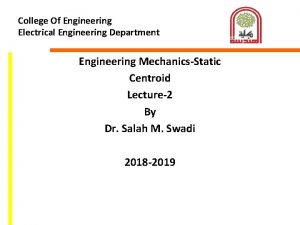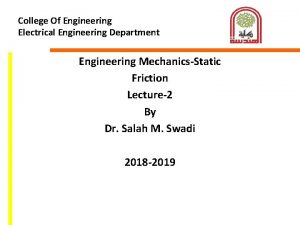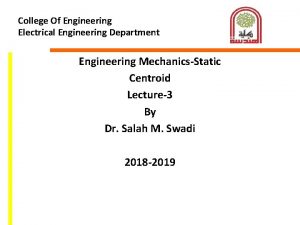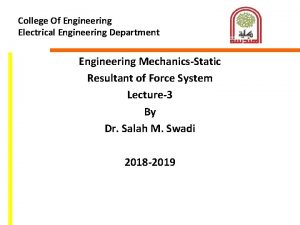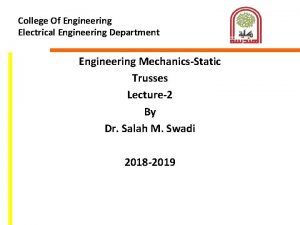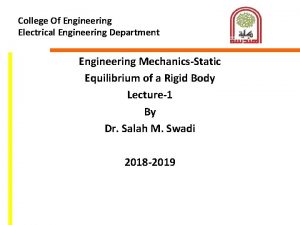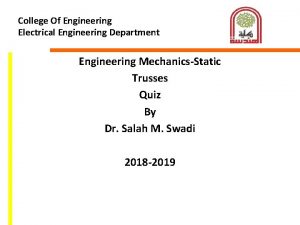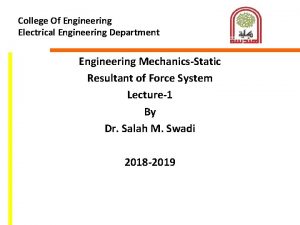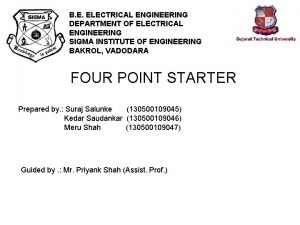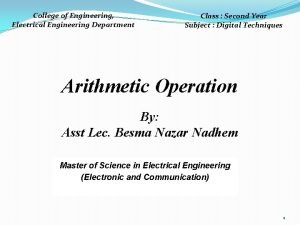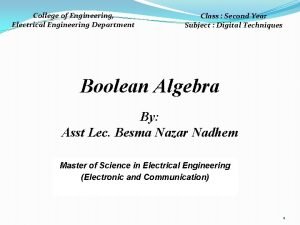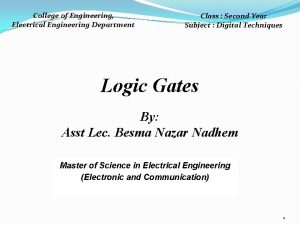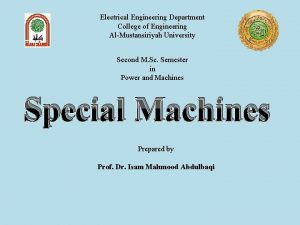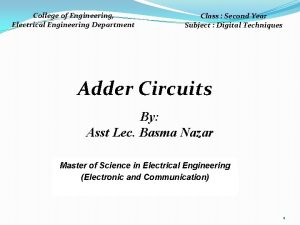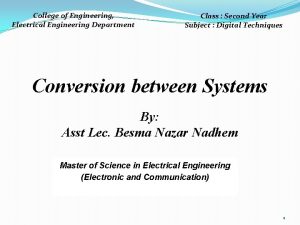College Of Engineering Electrical Engineering Department Engineering MechanicsStatic


























- Slides: 26

College Of Engineering Electrical Engineering Department Engineering Mechanics-Static Equilibrium of a Rigid Body Lecture-2 By Dr. Salah M. Swadi 2018 -2019

5. 3 Equations of Equilibrium • For equilibrium of a rigid body in 2 D, ∑Fx = 0; ∑Fy = 0; ∑MO = 0 • ∑Fx and ∑Fy represent sums of x and y components of all the forces • ∑MO represents the sum of the couple moments and moments of the force components

5. 3 Equations of Equilibrium Alternative Sets of Equilibrium Equations • For coplanar equilibrium problems, ∑Fx = 0; ∑Fy = 0; ∑MO = 0 • 2 alternative sets of 3 independent equilibrium equations, ∑Fa = 0; ∑MA = 0; ∑MB = 0

5. 3 Equations of Equilibrium Procedure for Analysis Free-Body Diagram • Force or couple moment having an unknown magnitude but known line of action can be assumed • Indicate the dimensions of the body necessary for computing the moments of forces

5. 3 Equations of Equilibrium Procedure for Analysis Equations of Equilibrium • Apply ∑MO = 0 about a point O • Unknowns moments of are zero about O and a direct solution the third unknown can be obtained • Orient the x and y axes along the lines that will provide the simplest resolution of the forces into their x and y components • Negative result scalar is opposite to that was assumed on the FBD

Example 5. 5 Determine the horizontal and vertical components of reaction for the beam loaded. Neglect the weight of the beam in the calculations.

Solution Free Body Diagrams • 600 N represented by x and y components • 200 N force acts on the beam at B

Solution Equations of Equilibrium

5. 4 Two- and Three-Force Members Two-Force Members • When forces are applied at only two points on a member, the member is called a two-force member • Only force magnitude must be determined

5. 4 Two- and Three-Force Members • When subjected to three forces, the forces are concurrent or parallel

Example 5. 13 The lever ABC is pin-supported at A and connected to a short link BD. If the weight of the members are negligible, determine the force of the pin on the lever at A.

Solution Free Body Diagrams • BD is a two-force member • Lever ABC is a three-force member Equations of Equilibrium Solving,

5. 5 Free-Body Diagrams Support Reactions As in the two-dimensional case: • A force is developed by a support • A couple moment is developed when rotation of the attached member is prevented • The force’s orientation is defined by the coordinate angles α, β and γ

5. 5 Free-Body Diagrams

5. 5 Free-Body Diagrams

Example 5. 14 Several examples of objects along with their associated free-body diagrams are shown. In all cases, the x, y and z axes are established and the unknown reaction components are indicated in the positive sense. The weight of the objects is neglected.

Solution

5. 6 Equations of Equilibrium Vector Equations of Equilibrium • For two conditions for equilibrium of a rigid body in vector form, ∑F = 0 ∑MO = 0 Scalar Equations of Equilibrium • If all external forces and couple moments are expressed in Cartesian vector form ∑F = ∑Fxi + ∑Fyj + ∑Fzk = 0 ∑MO = ∑Mxi + ∑Myj + ∑Mzk = 0

5. 7 Constraints for a Rigid Body Redundant Constraints • More support than needed for equilibrium • Statically indeterminate: more unknown loadings than equations of equilibrium

5. 7 Constraints for a Rigid Body Improper Constraints • Instability caused by the improper constraining by the supports • When all reactive forces are concurrent at this point, the body is improperly constrained

5. 7 Constraints for a Rigid Body Procedure for Analysis Free Body Diagram • Draw an outlined shape of the body • Show all the forces and couple moments acting on the body • Show all the unknown components having a positive sense • Indicate the dimensions of the body necessary for computing the moments of forces

5. 7 Constraints for a Rigid Body Procedure for Analysis Equations of Equilibrium • Apply the six scalar equations of equilibrium or vector equations • Any set of non-orthogonal axes may be chosen for this purpose Equations of Equilibrium • Choose the direction of an axis for moment summation such that it insects the lines of action of as many unknown forces as possible

Example 5. 15 The homogenous plate has a mass of 100 kg and is subjected to a force and couple moment along its edges. If it is supported in the horizontal plane by means of a roller at A, a ball and socket joint at N, and a cord at C, determine the components of reactions at the supports.

Solution Free Body Diagrams • Five unknown reactions acting on the plate • Each reaction assumed to act in a positive coordinate direction Equations of Equilibrium

Solution Equations of Equilibrium • Components of force at B can be eliminated if x’, y’ and z’ axes are used

Solution Solving, Az = 790 N Bz = -217 N TC = 707 N • The negative sign indicates Bz acts downward • The plate is partially constrained as the supports cannot prevent it from turning about the z axis if a force is applied in the x-y plane
 Electrical engineering department
Electrical engineering department Tum department of electrical and computer engineering
Tum department of electrical and computer engineering Ucla electrical engineering department
Ucla electrical engineering department Pasadena city college police department
Pasadena city college police department Elektro vektor
Elektro vektor Gwu electrical engineering
Gwu electrical engineering Tel aviv university electrical engineering
Tel aviv university electrical engineering Northwestern electrical engineering
Northwestern electrical engineering Klipsch school of electrical and computer engineering
Klipsch school of electrical and computer engineering Electrical engineering umd
Electrical engineering umd Electrical wiring estimating and costing
Electrical wiring estimating and costing Electrical engineering environmental issues
Electrical engineering environmental issues Wpi
Wpi Electrical engineering presentation
Electrical engineering presentation Electrical engineering kfupm
Electrical engineering kfupm Big data in electrical engineering
Big data in electrical engineering Chapter 11 electrical engineering
Chapter 11 electrical engineering Basic electrical engineering kulshreshtha
Basic electrical engineering kulshreshtha University of belgrade school of electrical engineering
University of belgrade school of electrical engineering Electrical engineering notation
Electrical engineering notation Bus electrical engineering
Bus electrical engineering Hello im human
Hello im human Clemson electrical engineering
Clemson electrical engineering Usf electrical engineering faculty
Usf electrical engineering faculty Phasors in electrical engineering
Phasors in electrical engineering Electrical engineering technion
Electrical engineering technion Kth master electrical engineering
Kth master electrical engineering




